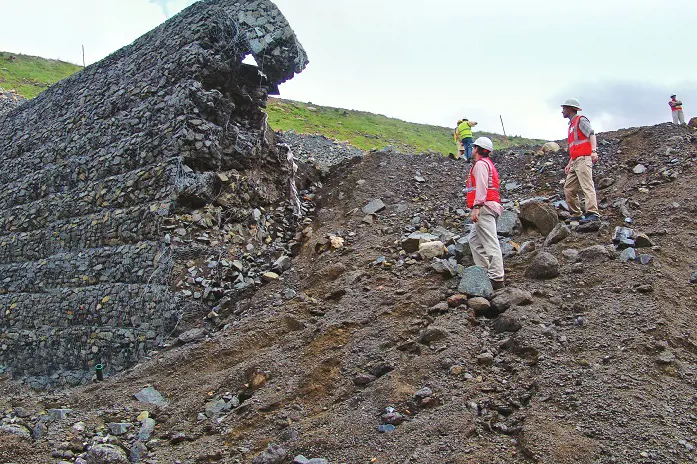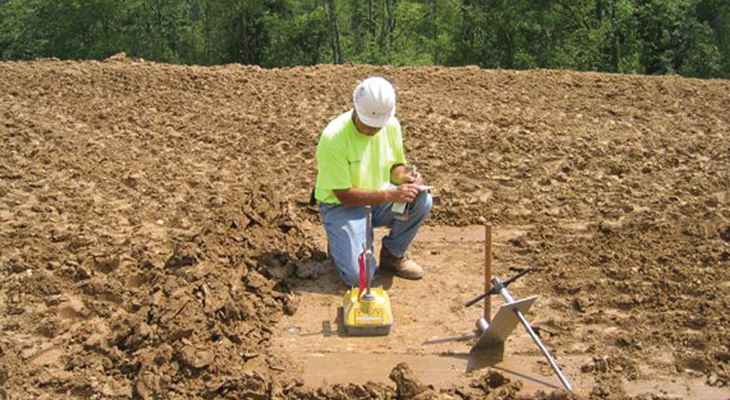Geotechnical Engineer Description: What to Get out of These Professionals
Wiki Article
Investigating the Interdisciplinary Nature of Geotechnical Design and Its Impact on Ground Renovation and Foundation Style
The interdisciplinary nature of geotechnical design plays a critical function fit ingenious ground improvement methods and foundation style approaches. By incorporating understandings from structural, ecological, and geological self-controls, geotechnical engineers are equipped to resolve complex dirt habits and site-specific difficulties. This collective method not just enhances the effectiveness of strategies such as soil stabilization and vibrant compaction but likewise makes certain that tasks comply with sustainability concepts. What implications does this interdisciplinary harmony have for future advancements in the area, particularly in the context of arising building and construction innovations?Summary of Geotechnical Engineering
Geotechnical design is an essential branch of civil engineering that concentrates on the behavior of planet products and their interaction with frameworks. This self-control includes the research study of dirt, rock, and groundwater, intending to recognize their residential or commercial properties and exactly how they affect the efficiency of civil design jobs. Geotechnical designers analyze the hydraulic and mechanical actions of these products to make certain the security and safety of frameworks such as buildings, bridges, and preserving wall surfaces.The extent of geotechnical engineering consists of site investigations, soil sampling, and screening, along with evaluation of dirt auto mechanics and rock auto mechanics. Designers utilize advanced methods to assess ground problems, identify potential dangers, and design reliable ground improvement services. This might include approaches such as soil stabilization, grouting, and making use of geosynthetics, which enhance the stamina and durability of the ground.
In addition, geotechnical design plays an essential function in foundation layout, identifying ideal foundation types based upon soil attributes and loading problems. By including strenuous screening and analysis, geotechnical engineers contribute significantly to the sustainability and strength of infrastructure, making certain that frameworks can stand up to environmental and functional stress and anxieties with time.
Key Interdisciplinary Relationships

Additionally, environmental design plays an important role in analyzing the impact of geotechnical tasks on the bordering ecological community. This collaboration is necessary for developing sustainable practices that lessen ecological deterioration during excavation or ground improvement processes.
Additionally, the integration of geotechnical engineering with geology boosts the understanding of subsurface problems, facilitating more accurate website characterizations (geotechnical engineer description). This partnership aids in hazard analysis, particularly in areas vulnerable to landslides or seismic activity, thus notifying threat mitigation methods
Finally, innovations in technology have caused interdisciplinary collaboration with data scientific research and geoinformatics. These fields add to boosted modeling and evaluation methods, permitting a lot more exact forecasts of dirt actions under various conditions. Therefore, the interconnectedness of these self-controls enhances geotechnical design, promoting advancement and effectiveness in foundation design and ground renovation.
Ground Improvement Techniques
Ground improvement techniques are important approaches employed to enhance the design homes of dirt, consequently enhancing its load-bearing capacity and stability. These strategies are particularly essential in locations where natural dirt problems are insufficient for supporting structural tons or where environmental aspects might endanger dirt honesty.Usual ground enhancement approaches include soil compaction, which increases thickness and decreases void areas, and grouting, which involves infusing products into soil to fill spaces and bind fragments with each other - geotechnical specialist. Other techniques include the setup of dirt nails and anchors, which supply extra assistance, and using geosynthetics to strengthen dirt structures. Deep mixing methods, such as soil-cement columns, can additionally substantially improve the toughness and rigidity of weak soils
In addition, vibrant compaction and vibro-replacement strategies are typically utilized to boost soil homes sitting. These methods can mitigate issues connected to negotiation and liquefaction, specifically in seismic areas. By employing a combination of these ingenious strategies, geotechnical designers can successfully resolve site-specific difficulties, making certain that the structure systems will certainly execute adequately under anticipated loading problems, hence adding to overall task success.
Foundation Layout Factors To Consider
Reliable structure style considerations are vital for the longevity and security of frameworks. A properly designed structure should effectively support the load of the structure while suiting dirt conditions, ecological variables, and possible adjustments in time. Key factors include dirt bearing capacity, negotiation qualities, and groundwater problems.Recognizing the soil account via geotechnical investigations is essential, as it educates the choice of structure type-- be it shallow, deep, or specialized techniques such as heap foundations or mat foundations. The expected tons, including click here to read online, dead, and environmental loads, have to be properly calculated to make sure the structure can resist possible view it now failing systems, such as gliding, rescinding, or excessive negotiation.
In addition, considerations for frost deepness, seismic activity, and potential soil liquefaction in seismic areas are critical. In addition, drainage and dampness control have to be incorporated into the foundation style to minimize problems connected to hydrostatic pressure and dirt erosion.
Cooperation amongst designers, designers, and geotechnical specialists is important to create an extensive foundation style that not just fulfills regulatory demands however additionally makes sure the long-term performance and safety of the framework. Ultimately, thorough planning and cutting-edge services are essential to deal with the complexities inherent in structure style.
Instance Researches and Ideal Practices

One noteworthy case research involves the use of deep soil blending in a high-rise building project in a seismic zone. This technique dramatically enhanced the dirt's strength and stability, allowing for a safer and extra reliable foundation system (all about geotechnical engineering). The job highlighted the importance of choosing appropriate ground enhancement methods based on site-specific conditions, consisting of dirt type and loading demands
One more example is the application of dynamic compaction for boosting the bearing ability of weak dirts beneath an industrial center. This method successfully lowered negotiation problems and boosted overall site performance, demonstrating the efficiency of combining typical design techniques with modern innovation.
Finest practices acquired from these situation research studies highlight the need of comprehensive site investigations, cooperation among multidisciplinary teams, and the incorporation of advanced modeling tools. By taking on these lessons, geotechnical designers can maximize structure layouts and ground renovation methods, ultimately leading to more secure and more lasting building outcomes.
Final Thought
In conclusion, the interdisciplinary nature of geotechnical design considerably enhances ground improvement and foundation design. By incorporating concepts from various design disciplines, tailored methods are created to address particular obstacles connected to dirt properties and ecological effects. This joint method not just makes sure find out this here optimum structure security and safety and security however likewise advertises lasting construction techniques. Continued expedition of these interdisciplinary connections will certainly further advance the field, bring about innovative services that react efficiently to progressing design needs.The range of geotechnical design consists of website investigations, dirt sampling, and screening, as well as analysis of dirt auto mechanics and rock technicians. The partnership between geotechnical design and architectural design is particularly important, as the performance of structures is heavily influenced by soil actions and buildings.Usual ground improvement methods include soil compaction, which raises thickness and decreases void rooms, and grouting, which includes injecting materials into dirt to fill up spaces and bind particles with each other. Other strategies include the installation of dirt nails and anchors, which supply added assistance, and the usage of geosynthetics to strengthen soil frameworks. A properly designed foundation needs to adequately sustain the lots of the building while fitting dirt conditions, environmental factors, and possible adjustments over time.
Report this wiki page